After a very long but enjoyable few weeks of on-field action, the World Cup is now firmly on the home straight, with just four matches left to play before one of Argentina, Croatia, France and Morocco gets their hands on the famous gold trophy. Both semi-finals are shaping up to be hugely enjoyable contests, with plenty of fans around the world expected to tune in as they wait to see who will reach Sunday’s final and who will fall short at the last hurdle.
This tactical analysis will preview all of the action from the second of those last four games, which sees history-makers Morocco face defending champions France. The analysis will provide updates on injuries, suspensions and other team news, as well as detail what to expect from both sides in attack, defence and during transitions at the Al Bayt Stadium and provide a potential outcome.
Team news
France managed to get through their quarter-final against England with no injuries or suspensions being picked up, so Didier Deschamps will have a full squad to choose from on Wednesday as he looks to seal a place in Sunday’s showdown. With that in mind, it is a fair assumption to make that he will name the same starting eleven as he did on Saturday, barring anything happening between now and then.
The same cannot be said for Morocco, however, with some in the media describing them as “walking wounded” ahead of the biggest game in their footballing history. Full-back Noussair Mazraoui and West Ham United defender Nayef Aguerd both sat the win against Portugal out with illness and injury problems, whilst captain and former Wolves player Romain Saïss was taken off on a stretcher during the match, so the Atlas Lions are thin on the ground when it comes to defensive options.
Forward Walid Cheddira will also miss this game, with the Bari player suspended after picking up two yellow cards as a substitute last time out, so there will be some big personnel decisions for head coach Walid Regragui to make ahead of the game getting underway as he looks to help his side cause yet another tournament shock.
France’s attack
With the options that France have in forward areas, it would have been a surprise to see them not play the majority of their games on the front foot. However, the way that they have gone about constructing their offensive play has been really clever, as it has always been about the team and not just about what Kylian Mbappé can do.

When looking for two players who have had a significant impact on their attacking play, it is difficult to look past the full-backs, with Deschamps’ tactics seeing them push higher up the field when Les Bleus have the ball in order to support those further up the field. Generally, it has been Barcelona’s Jules Koundé and AC Milan’s Theo Hernandez who have started in these roles, and both are either level with or ahead of the ball here and are offering good passing options.
It is worth noting that Hernandez is the furthest forward of the two, which might be due to Koundé being a centre-back by trade and therefore more inclined to stay back, or it might be tactical. However, whichever it is doesn’t matter, because the key thing to focus on here is how the rest of the team work to enable them to move into dangerous areas. In this case, Mbappé has spotted Hernandez’s run and has dropped back, as illustrated by the yellow arrow, giving his teammate space to move behind the Polish defensive line.
This positional switch between the two players now leaves Poland with a difficult choice to make, as they can either follow Mbappé and close him down or hold their positions and focus on protecting the goal. It doesn’t matter which they choose to do, as France will have time and space to keep the attack alive either way, and this is why having attacking full-backs and forwards who can work together to create spaces in this way always makes for a good tactical combination.
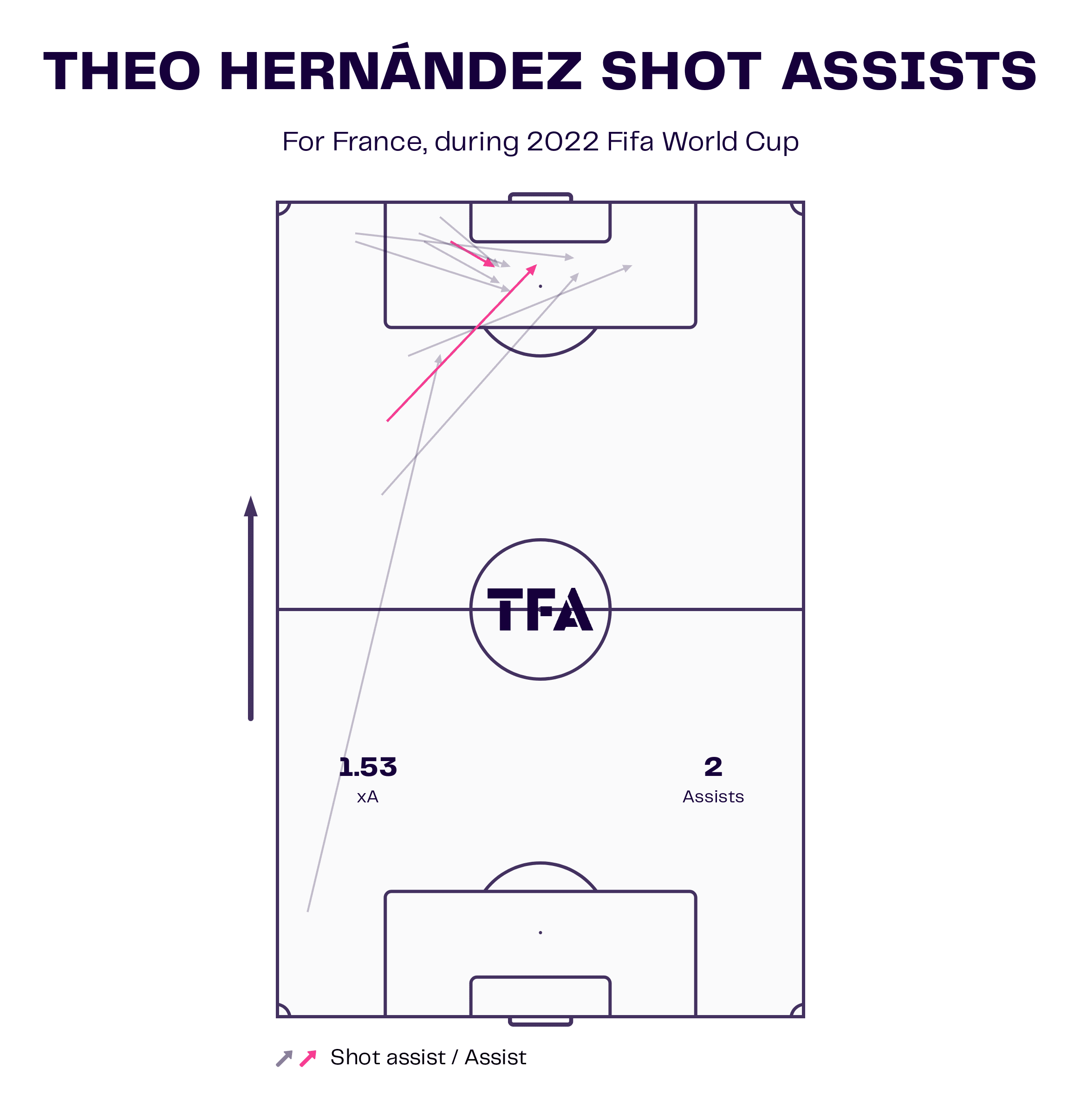
When Hernandez is in advanced areas, he can always be relied upon to deliver dangerous balls that give the opponents problems, and this graphic indicates the number of times that he has created goalscoring opportunities from the wide channel.
However, what is just as interesting is that the two crosses that led to goals both came from different areas, with one pink arrow starting inside the box and the other coming from further back. Therefore, what this shows is that the AC Milan player poses a significant threat wherever he is on the field, and, if France are to have any hope of getting past a robust Morocco side, they will need him to display significant accuracy with his crosses in order to keep the Atlas Lions on the back foot.

When it comes to their forward line, France’s 4-3-3 setup has only allowed them to play with one centre forward in each match. However, with Deschamps wanting to have all three of Antoine Griezmann, Mbappé and Olivier Giroud on the field at the same time, he has needed to be clever with how he has set his team up during their games so far.
What has generally been the case is that Giroud has been used as the target player, leading the line, whilst Mbappé has been in a wide-forward role to give him more freedom to move around the pitch and affect the game in different ways. However, Griezmann has not been named in the forward line at all and has instead been included as more of a midfielder. Whilst this has enabled him to disrupt play and help to protect the back line, it has also allowed him to push forward and join those ahead of him, forming a front four at times.
As can be seen here, playing this way gives France an additional target to find when crossing the ball into the central areas, increasing their chances of scoring every time the ball enters the goal area, and this is another important aspect of their attacking play that fans can expect to see on Wednesday, with France knowing that they will have to take control of the game early on to avoid going the same way as Spain and Portugal.
France’s defence
Once they lose the ball, however, France’s shape alters and their focus turns towards occupying as much of the pitch as possible, and this is where their ability to work together again becomes vital.
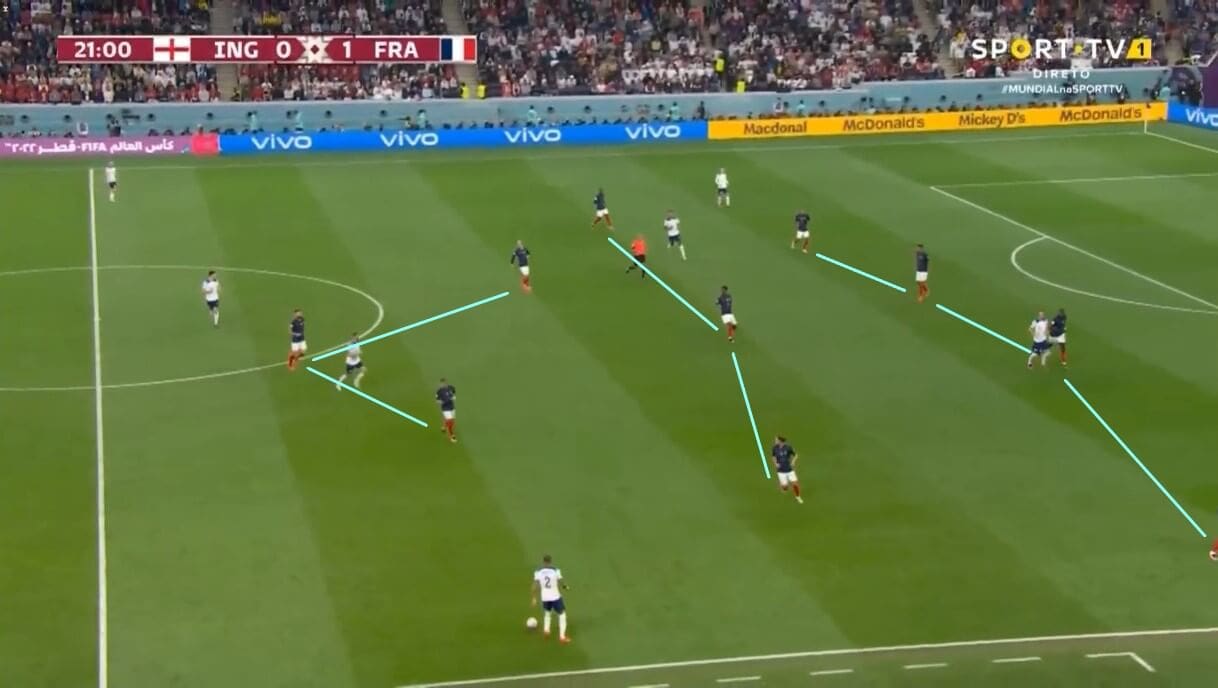
Firstly, the role of the forward line is to remain compact and not spread out too much, with them forming almost an arrow-shaped setup here in their efforts to not leave spaces open and make it easy for their opponents to play through them, with the result being that England, in this case, are now forced into playing the ball towards the wings.
However, that is where the midfielders come in, as they also stay compact but have the ability to get out and prevent the ball from progressing any further up the field too, with Adrien Rabiot demonstrating that here as Kyle Walker is looking to move up the pitch. Once the ball is then passed backwards and across to the other side of the field, Rabiot then moves back inside and the player on the other side goes out towards it, performing the same role, and this continues until France are able to retake possession.
Should the ball ever reach the defensive line, then they are also spread out and are aiming to cover as much ground as possible, but with a bias towards the side of the pitch that the ball is currently on (and that also changes as it is passed around). Their aim is to provide support for the midfielder ahead of them, ensuring that, if the attacking side try to create numerical overloads against them, they can’t take the ball into the goal area. Put all of this together, and the team ethic that has made France such a difficult side to play against is once again prominent.
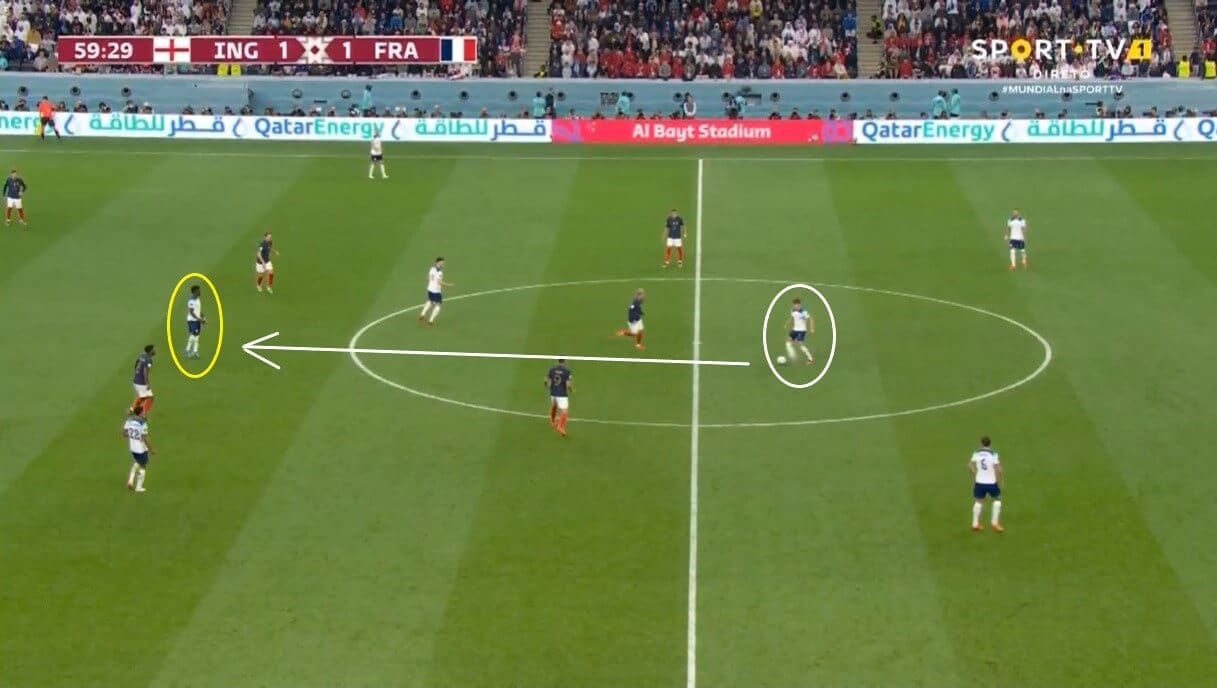
However, this only works if the ball can be forced into the wide channels by the first line of defence. If that isn’t possible and gaps are left open, then France are often on the back foot and are easier to break down.
This was evident in the defeat to Tunisia during the final round of group games when Wahbi Khazri took advantage of a lapse in concentration to break through the middle of the French setup, whilst England also found this weakness and looked to position Arsenal’s Bukayo Saka in the middle as often as possible. Every time he got the ball, as he has here from John Stones, France never seemed to know how to deal with him and constantly gave him acres of space to operate in, and this was one of the reasons that, despite exiting the tournament in this game, England were the better side against Les Bleus.
Therefore, if France want to have a chance of stopping Morocco’s historic run in this tournament, they will need to work on their soft underbelly and ensure that the likes of Chelsea’s Hakim Ziyech are not able to exploit it, otherwise, there is a possibility that they could be on the end of another World Cup shock.
France’s transitions
During transitions, the ability of France’s players to play in different positions and get on the ball in different areas of the pitch has been central to both their attacking threat and their defensive play, and it is one reason that Morocco may find it difficult to contain them when their semi-final meeting gets underway.
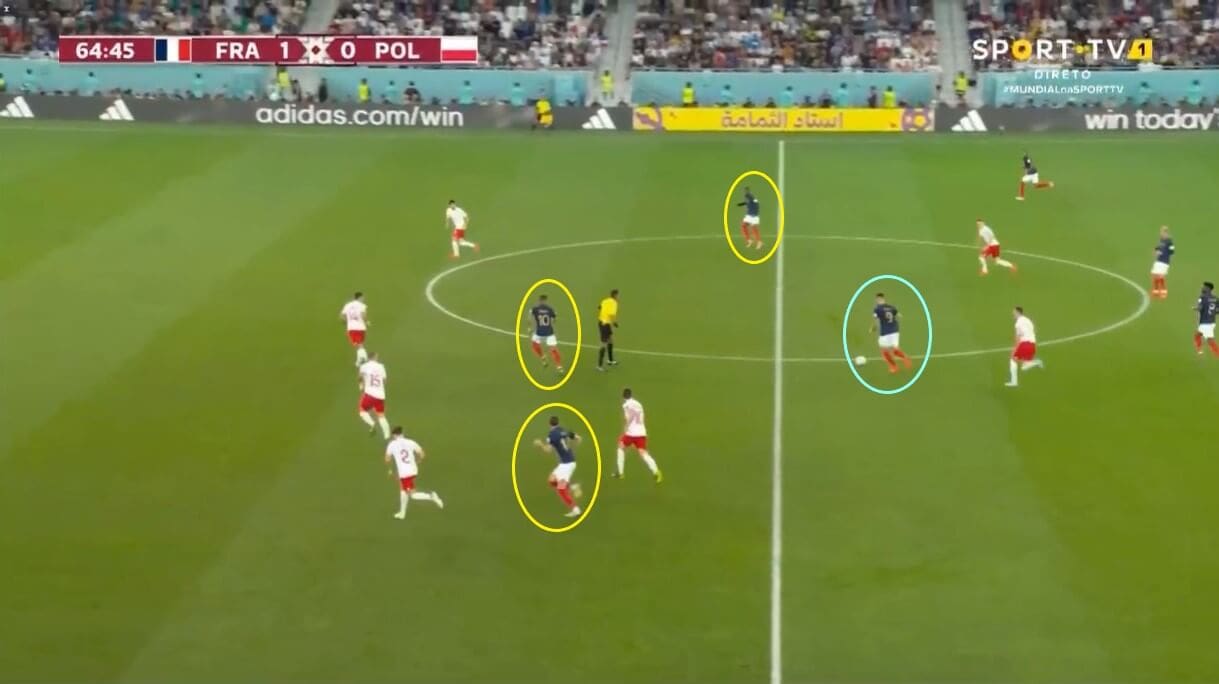
The reason that their ability to switch positions when they win the ball is so important is because it creates passing options, not only for the initial short pass but also for the next phase of each attack.
To explain, Giroud has moved towards the midfield here to receive a short pass, but the fact that he is the target player means that France now don’t have an option ahead of him to pass the ball to next. This is where Rabiot, Mbappé and Ousmane Dembélé come into play, as all three make runs beyond Giroud to give him those options, ensuring that, when he turns and looks up the field, he can keep their attack alive.
Therefore, by building through phases and getting the details of their transitions right, France will always be a danger to their opponents, and this is something that Morocco will need to watch whenever they concede possession.
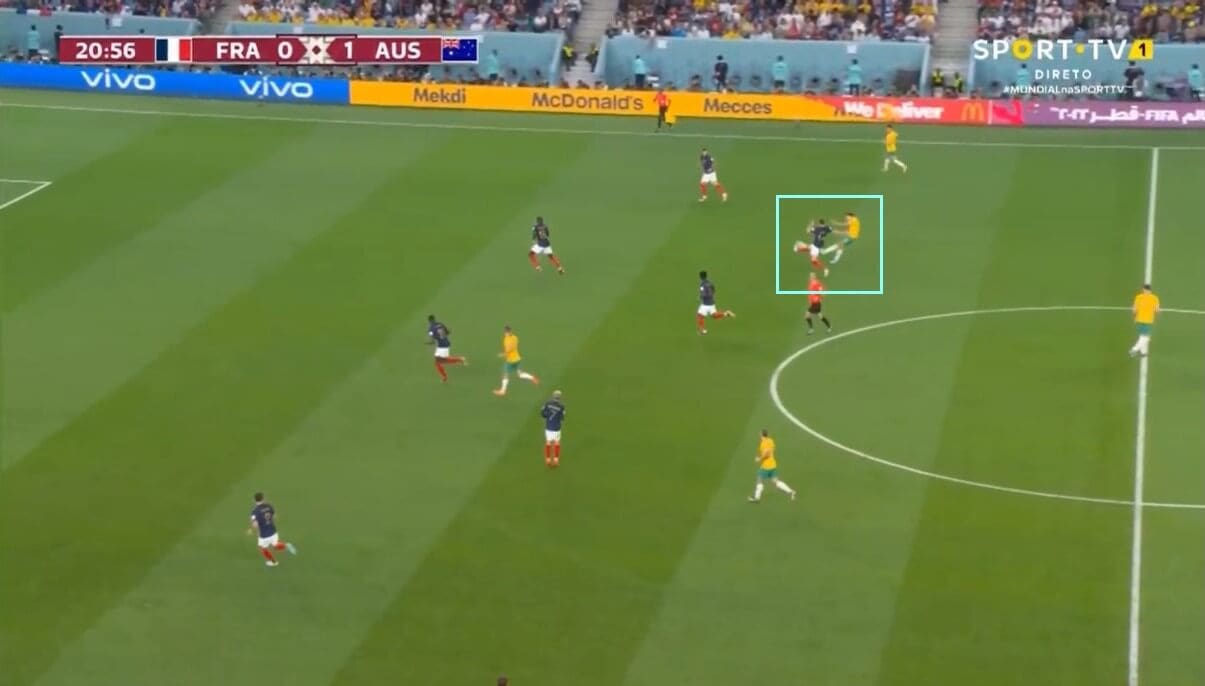
Once the ball is lost, as has already been shown in this analysis, they fall back into their shape and look to prevent the ball from moving too far up the field. However, this is not always possible, due to opponents counterattacking at speed and not giving them time to set their defensive structure up. This is where players who can disrupt play come in, with Rabiot especially important in this aspect of the game, most notably in the early stages of the tournament as the rest of the French players settled into the matches.
In their opening group game against Australia, France took a while to establish themselves in the match and were on the back foot for large parts of the first half. However, the reason that they didn’t go more than one goal down against the Socceroos was because of players like Rabiot closing balls down and ending attacks before they could lead to anything. In this case, he made a tackle just in time, with Australia preparing to shoot at goal, and it was situations like this that demonstrated why he would be such a vital cog in the French machine as the tournament went on.
With Morocco tending to use spaces as they build play, he will need to keep working hard to break their attacks up if his side are to make it to Sunday’s final.
Morocco’s attack
Switching the focus to the Atlas Lions, what is been clear throughout the last three weeks is that, when they move the ball around the pitch, they do so in a calm and measured way.
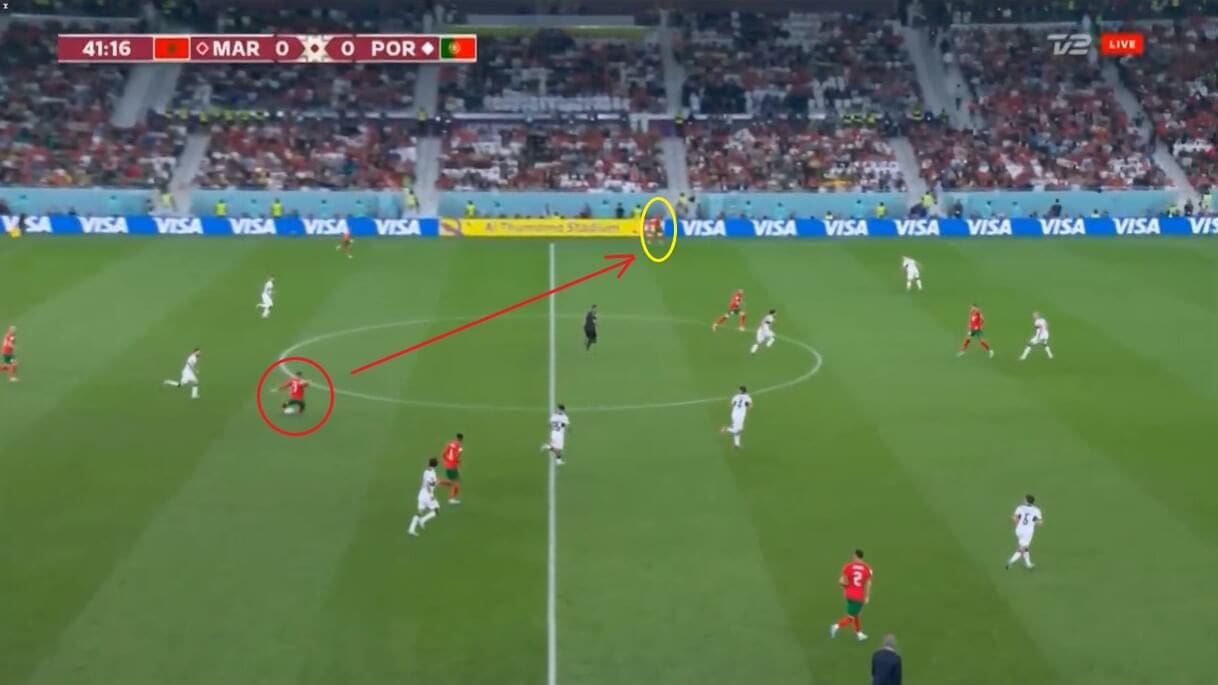
That is particularly evident here, with Morocco looking to transfer the ball up the field and into an area where they can create a goalscoring opportunity. However, rather than all rushing forwards at once, they take their time and wait for the spaces to open up, with Ziyech holding onto the ball for a fraction of a second longer than others might have done before exploiting a gap in Portugal’s defensive structure to find ex-Southampton forward Sofiane Boufal on the far side of the field.
The key thing to note here is that every Moroccan player always gets their head up when they have the ball and looks for spaces, and that will be of huge benefit to them against France as it will allow them to control the flow of the match and will make them less likely to give the ball away in cheap circumstances, both of which will lead to them having a better chance of exploiting any gaps that France do leave open.
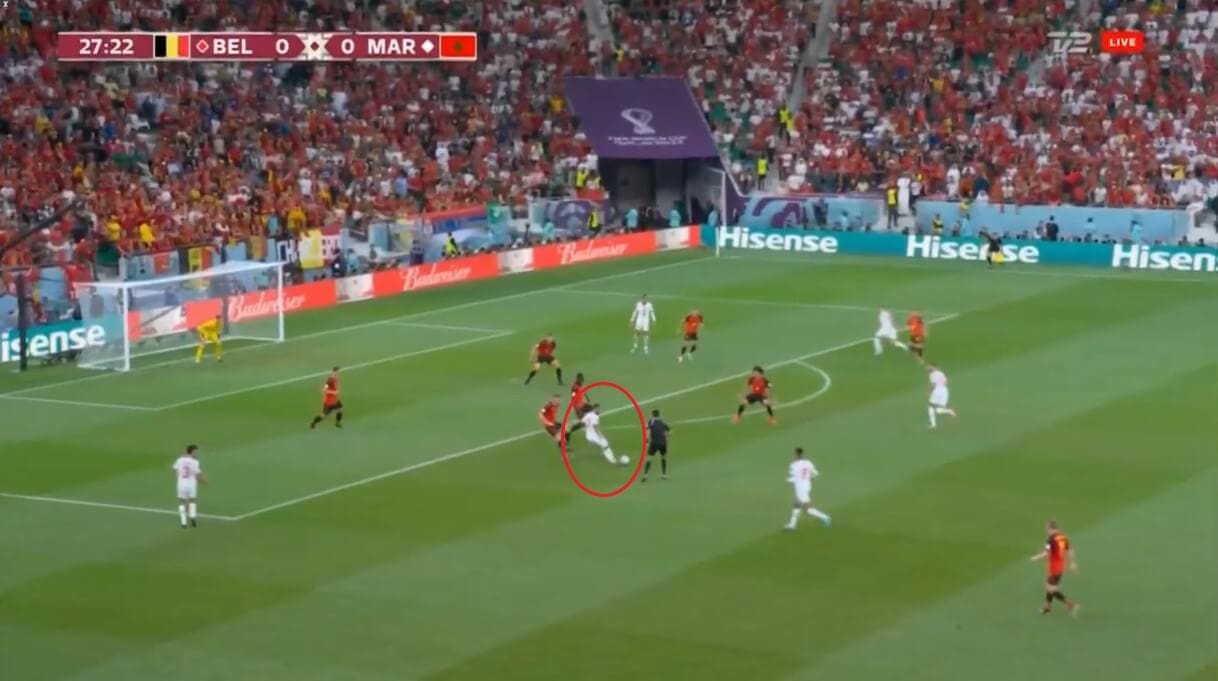
Like France, there is a strong emphasis on teamwork in everything that they do. In the final third, that means that their players know that they can send balls into the goal area and there will always be a teammate either in position or making a run to shoot at goal or keep the attack alive. In this case, Boufal is doing just that, with him identifying an unoccupied area on the far side of the goal area, and, even though this move ends with Selim Amallah firing over the crossbar, it demonstrates how they build up play and work as a team to create goalscoring chances.
With France looking ropey at the back when their opponents attack through the middle, this might be one thing that gives Morocco an advantage in the final third, and it would not be a surprise to see the likes of Ziyech and Boufal move into central areas as often as possible in order to take full advantage of that weakness.
Morocco’s defence
Morocco’s defensive mindset is also based around working as a team, and it is worth noting that they are brave in the way that they set up when out of possession, which can land them in difficult positions at times.
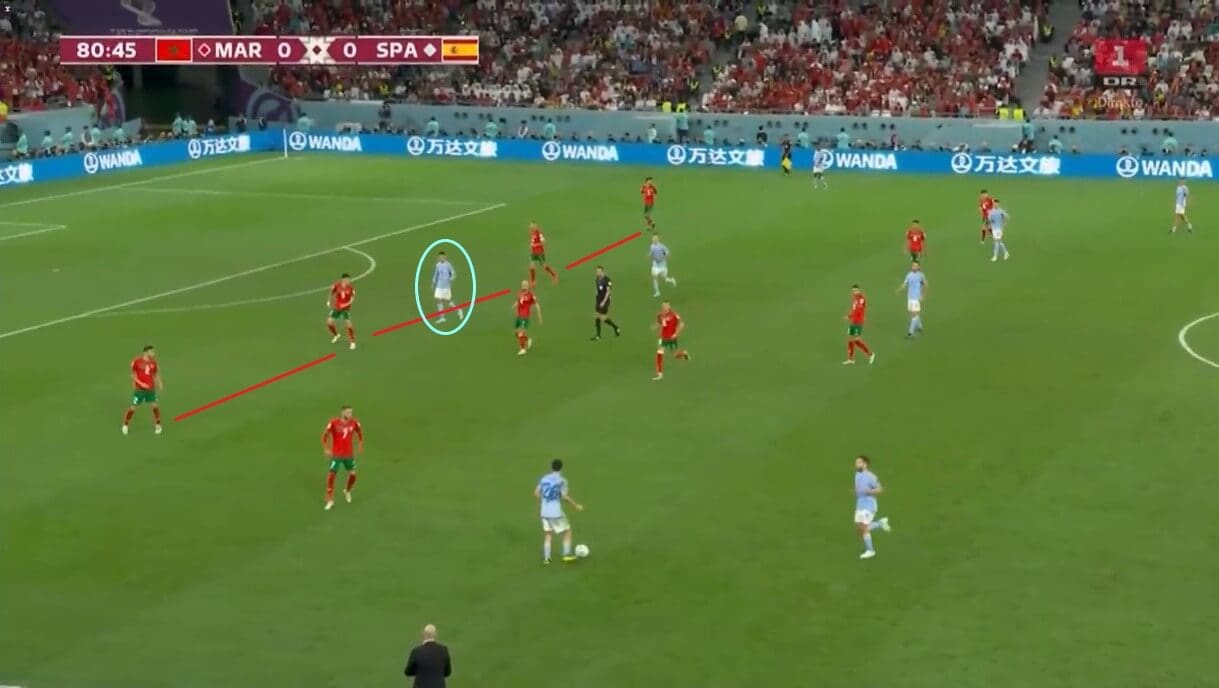
Here, their back line is well-organised, with equal spacing between the players as they try to limit what Spain can do in this situation. However, the issue is how far up the field they are, with the defensive line well outside the goal area, and this means that their opponents have a lot of space open behind that they can exploit if they can find the right pass. Spain are one of those sides that can hurt opponents in these situations, and Álvaro Morata is well-placed here to meet any cross that comes his way.
On this occasion, Morocco were let off by their opponents, who wasted the opportunity when they did manage to move into the space. However, France are unlikely to be as wasteful, and that is what the North African side will have to be wary of on Wednesday.
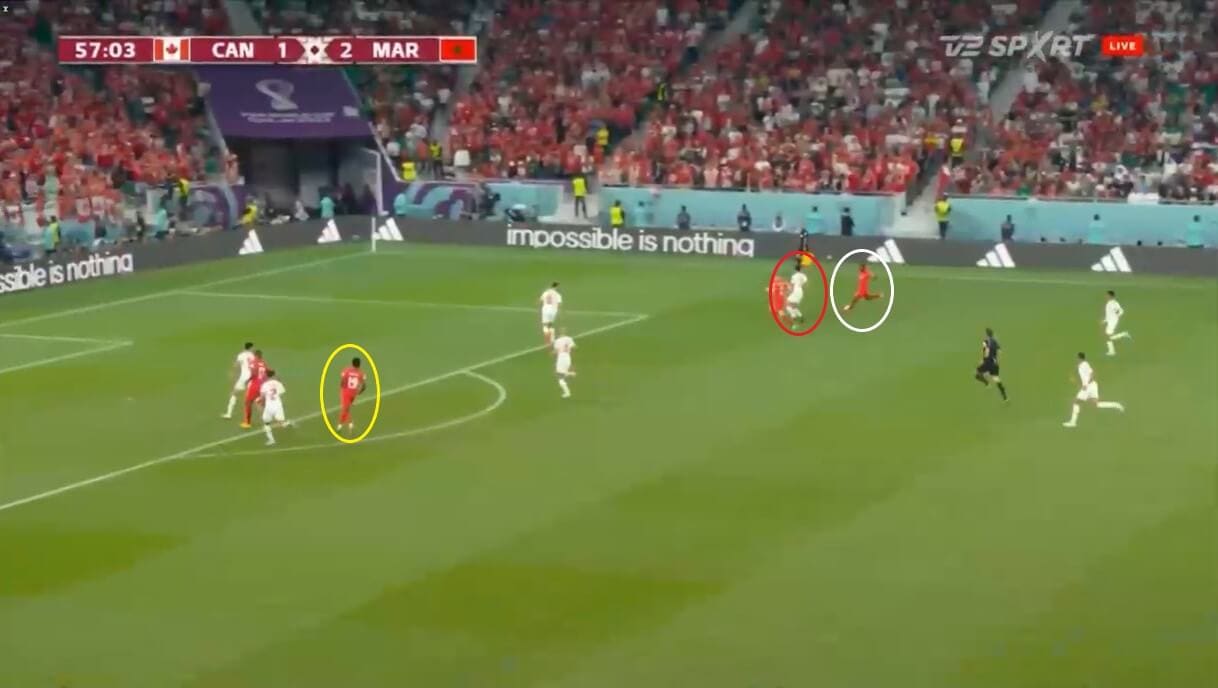
The other problem that Morocco have at the back is that, when they don’t have the same time to set up their shape, they have players all over the place and don’t look to slow down their opponents’ attacks. In this case, Canada winger Junior Hoilett is looking to send the ball into the middle and has Noussair Mazraoui for company, but the Morocco left-back is not making an effort to win the ball and is therefore not offering much defensively in this situation as a result.
Canada showed during their brief time at the tournament that they were very capable of creating opportunities, so it was dangerous for Mazraoui to leave Hoilett with as much space and time as he had here, and the fact that Alphonso Davies was able to get a shot away at goal when the cross came in shows that these are the moments where Morocco can be more solid defensively.
Therefore, against France, the Atlas Lions will need to show a lot more desire and organisation than this, because, whilst Canada were generally wasteful in front of goal, France have been mostly clinical when given chances like this.
Morocco’s transitions
As with a lot of their play, Morocco’s transitions have relied on the team’s overall speed and awareness both when they win possession and when they lose it, and playing with the same amount of energy and heart that they have shown throughout their time in Qatar so far will be critical if they are to keep France out and give themselves the best possible chance of progressing to the final.
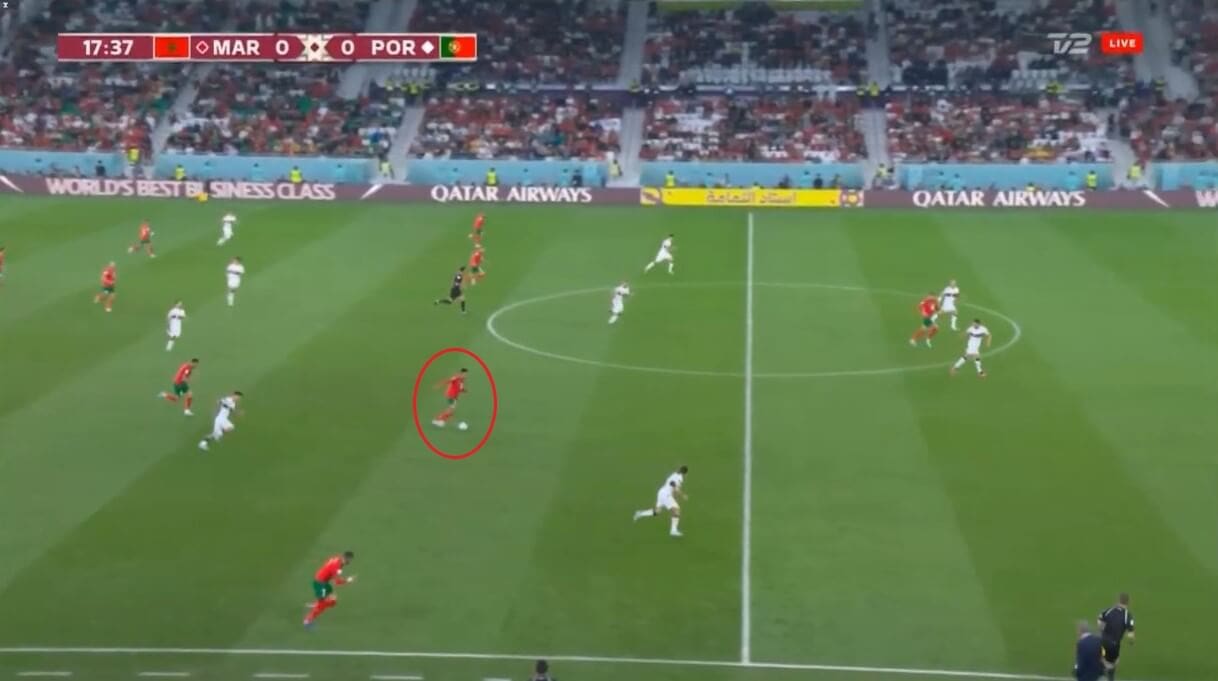
When examining how they move the ball out from the back, there is one player that has been instrumental. If fans of the game had never been aware of Angers’ Azzedine Ounahi, then they are now, because he has been central to everything that Morocco have done well during the tournament, with his speed and ability to dribble across long distances helping them to keep possession and wait for the right opportunities to pass the ball to the next player, and he was the driving force behind so much of what they did well against Portugal in their quarter-final, with the former European champions struggling to work out how to deal with him throughout the encounter.
It has been mentioned throughout the analysis that Morocco will need to get a lot of details right against France, but none of that will matter if Ounahi doesn’t perform on the day, because, whilst Ziyech and Youssef En-Nesyri take the headlines, he is the one who makes them tick.
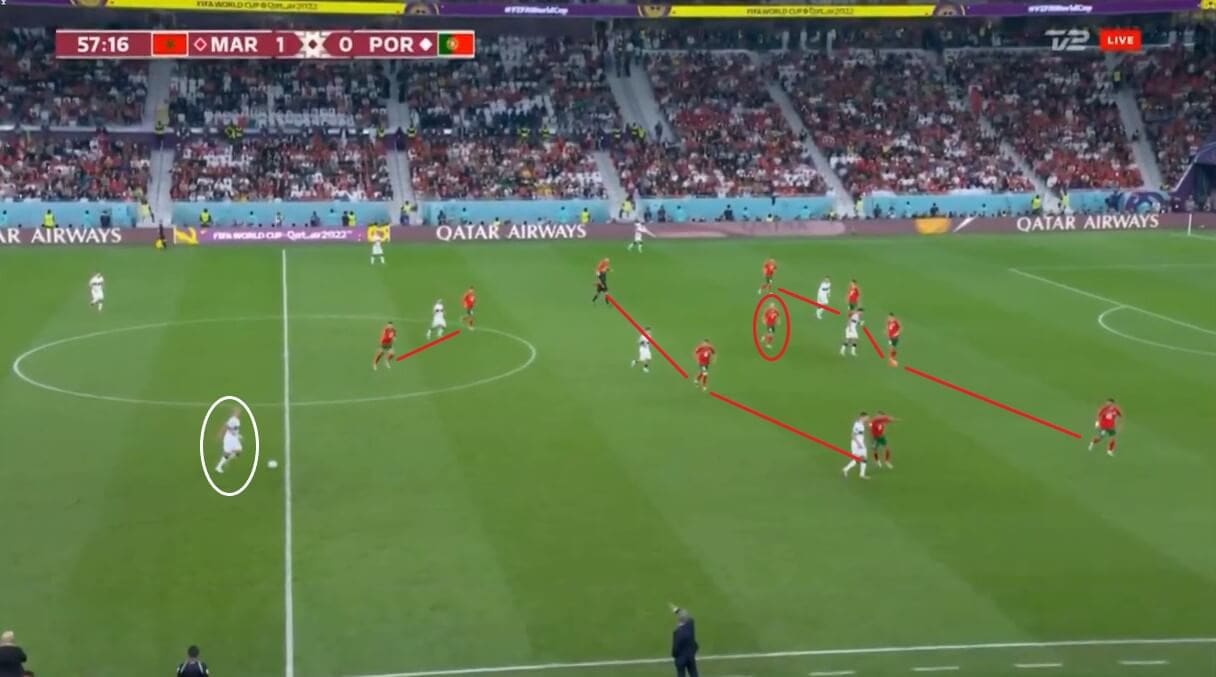
Once Morocco lose the ball, they, like France, have a shape that they fall back into. However, unlike France’s structure, the Atlas Lions are more flexible, with players switching positions and again demonstrating the teamwork that has got them so far into the knockout rounds.
Portugal defender Pepe has possession here but is unable to send the ball forwards due to the compactness of Morocco’s 4-1-3-2 setup, as it is at this stage, and his only available avenue now is down the wing. This always gives the defending team the advantage, as it is easier to block crosses than it is to stop attacks coming through the middle of the pitch, and this is why teams have found Morocco to be a tough opponent to break down.
If they can form these defensive structures against France, then Les Bleus will find it tricky to break them down. However, if they leave spaces open, as they did against Canada, then it might be an easier night for France than some are expecting.
Potential outcome
On paper, this looks to be a game that France should easily win, as a direct comparison of the squads immediately indicates that the European side have more players who compete regularly at some of the best clubs around the continent.
However, when examining the picture more closely, what becomes clear is that Morocco are a well-organised side that work together for the sake of getting results, and, as this preview has indicated, they have a lot of quality at both ends of the pitch and will be formidable opponents.
However, there is still the simple fact that they are missing several key defenders and France will have Mbappé in their ranks, and, despite Morocco having several players in their side who have starred at the tournament, such as Ziyech, Ounahi and Sofyan Amrabat, that could be what gives the defending champions the edge.
If Morocco can find a way of keeping him quiet, just as England did in the quarter-finals, then they will be able to stay in the game for longer and have a better chance of going through. If not, then it is hard to see beyond a French win and a chance for Deschamps’ side to become the first nation in 60 years to successfully defend a World Cup title.





Comments